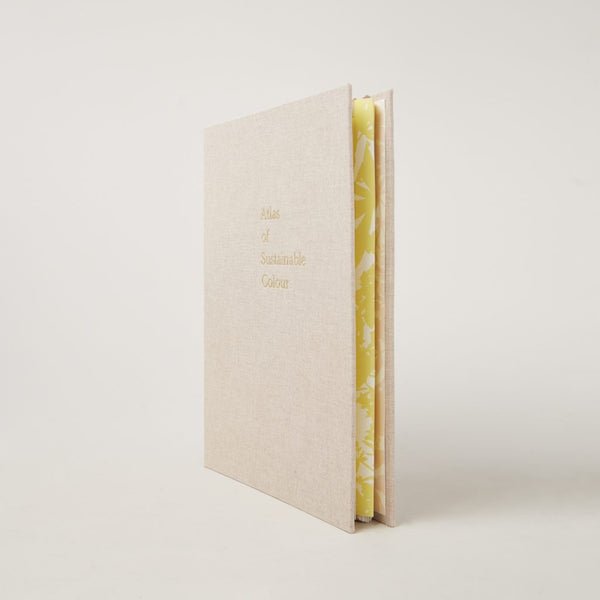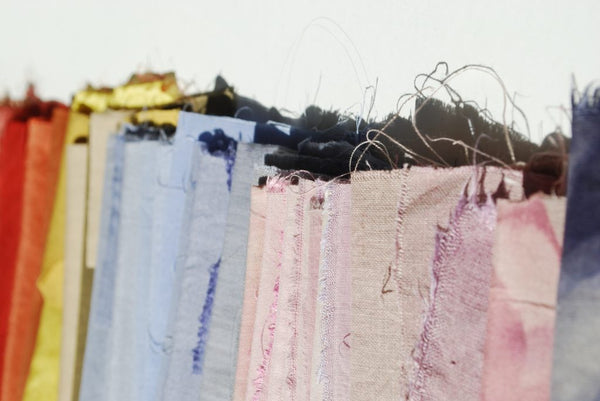
· By Tizz & Tonic
Atlas of Sustainable Colour(s)
Atlas of Sustainable Colour(s) - A home for all sustainable colour makers and users: dyers, designers, artists, startups and all people motivated by 'Colouriosity'.
As you might know we are participating in a circular fashion accelerator called Small But Perfect. This program is a collaborative project co-funded by the European Commission’s COSME Program and Fashion Revolution. This program supports the acceleration of circular and sustainable business models and helps to inspire change within the wider fashion industry. We are jazzed to be on this journey along with so many other cool brands from around the EU. Julia is one of the participants in our cohort and since she is a colour specialist obsessed with colour (like us), we wanted to take the chance to ask her more about the future of natural dyes and what she is working on for the Small But Perfect Accelerator.
Dive into it with this one-on-one interview with me (Yanna co-founder of Tizz & Tonic) and Julia (founder of Atlas of Sustainable Colours).
Yanna: Hey Julia! You are the founder of AoSC, and like us a colour enthusiast. Tell us about AoSC and your Colour Impact Catalogue project.
Julia: Yes, Atlas of Sustainable Colours originally is a book I developed to show shades and tones made with plants and bacteria on textiles This project is an outcome of an artistic research into alternative colouring for the textile industry and it was an attempt to catalogue artisanal natural dyes with innovative ways of colouring. This includes (but is not limited to) naturally pigmented bacteria, algae pigments and textile colours made out of clothing waste.

Now I am bringing AoSC to a bigger and digitised scale, and Colour Impact Catalogue is part of that endeavour. With my partners we want to accelerate sustainable practices in textile dyeing and printing whilst practising a mindful approach to colouring in the textile industry.
Through mapping local colour suppliers we want to bring colour production closer to where brands are located. One of the goals of our digital showroom is to elevate transparency in the dyeing industry by showing the real impact of available colouring methods, both conventional and innovative, nevertheless first we need to develop a methodology and find more data to compare impact to.
We are developing a framework to put colour suppliers into contact with brands and build a community around dyers, designers, artists, startups and all people motivated by Colouriosity.
Yanna: Colouriosity! I love that, a case of colorphilia if you will. Very cool. So how did you get started?

Julia: My background is in fashion design and I did my masters in Fashion Strategies/Critical fashion practices in Arnhem, NL and I already was pretty overwhelmed with how bad fashion was for the environment. It took me many years to make peace with the fact that I won't be designing anymore until I could find out how to make it in a very sustainable way. I saw there were so many amazing brands and designers out there, so I thought, okay, I can find a different way to support this transition to a healthier future.
Part of my Masters was about connecting to intuition and really finding your personal guiding values. I discovered that one of my values is respect. Especially when I go out into nature, I have a huge respect for nature. This, plus the aesthetics of sustainable fashion is actually where the origin for the concept came from. I remember at that time (2017) had a lot of talks with people and they were saying, yes, sustainable brands are nice, but they're boring and they are not colourful.
I then realised that there is a lack of these colours in sustainable fashion. As I explored this further I found that designers have access to a big selection of sustainable textiles but a small selection of sustainable colours.
 Photo credit: Bananenmuseum
Photo credit: Bananenmuseum
Fashion needs to be aesthetically pleasing. This won't change. People look to fashion for fun and joy and the ways of expression. So if you want to have sustainable fashion designers, you need to have access to sustainable tools to create sustainable aesthetics. Colour is one of those things which you really use to choose your clothes. We build our wardrobes around colour, and I realised that colour is so powerful, but such an often overlooked or neglected component of this aesthetic tool kit.
Dyeing is responsible for a huge water usage, and actually when you look into some research, the impact of dying is more damaging on the biodiversity than on just water usage, because of the toxic components in synthetic dyes.
I kept thinking why, why do we keep compromising nature and health of people in the name of the new colour of the year, which is only used to drive consumption and make you buy more. So that's the thinking process behind Atlas.
Yanna: Yea, you are right. How we approach colour in the design and production process should have more value than only looking at the textiles themselves. This is something that has also become more clear to us as we started transitioning to greener, more innovative textiles. As we grow and develop with our brand we also have been putting more attention to our designs and look at which colours or processes of colouring have less impact.
So I saw on the site you mentioned non-synthetic dyes, bacteria dyes, plant dyes, even flower dyes?! What do they look like? What are non-synthetic dyes actually?

Julia: Non-synthetic textile dyes are non fossil fuel based colours. Synthetic dyes are derived from petroleum products and they do not occur in nature. When I started my research and was looking more closely at colours, I was fascinated with those natural plant dyes and the bacterial dyeing. What is more, I learnt that naturally dyed clothes can have a higher level of protection against ultraviolet rays than ones dyed with synthetic dyes. Interestingly, naturally pigmented bacteria used for colouring textiles, amongst other things, have antibacterial properties, which in the future could support our immune systems.
It’s pretty cool, you can make dyes from plants, flowers, fruits and vegetables, bacteria, and even seaweed!

For my Masters project I invited five collaborators to dye the same set of textile samples. After they sent them back to me, I could create this chart which I developed into a physical book. In a very organic way, I actually created a palette of non-synthetic based dyes to show to others that there are options.
When looking at all these textile certifications and impact measurements assessments, I wanted to switch the conversation up a bit and ask brands and producers: “What is this relationship with your dye? Do you know where it comes from or how it is created?”. If a dyer wants to show their colours on the platform, they will also have to provide us with information about the colours' impact.
Yanna: I think there is a bit of this stigma around natural dyeing, as you mentioned earlier about boring colours of sustainable brands that the colours may not hold as well or are not aligned with the synthetic dye properties and standards.

Julia: What we want in the industry is to see an innovation of non-synthetic dyes, so that they can reach these standards. But it'll take time because we have had synthetic dyes for ca. 200 years now. They had this much time to actually innovate the synthetic dyes. So now we have to be patient with those startups to create natural bacterial dye, strong enough to not fade away. In my opinion, because we have little time for the climate we should also start using and embracing those natural colours and accept that they might fade over time in order to reduce the amount of synthetic dyes used.
Yanna: Plus who knows, the faded colours could be like having a new coloured garment!
So do you have a favourite colour you like to make or work with?
Julia: I love this question.
Yes, in the dyeing process I really like the light blues. I mean, I'm a person of blue colour. I just love blue. If I can wear navy or indigo clothes, this is definitely my go to.

Yanna: I am a blue fan too! So Julia, sustainability is a very broad concept I know but I still have to ask the big predictable question: what does sustainable fashion mean to you?
Julia (laughing): I think that for me, sustainable fashion is really about respecting and understanding the value of the whole production process. As a person who knows how to make clothes myself from scratch, how to make a pattern and everything is such a timely process that I really think that if everyone would know, actually, what does it take to make your clothes, we would be living in a different situation.
Appreciating, respecting and taking care of your clothes. This, for me, is what sustainable fashion is about.
Find out more about Julia and her project here. Plus be sure to check out their cool interview on the site with Zeefier, a Dutch startup developing natural dyes for textiles made out of seaweed!




